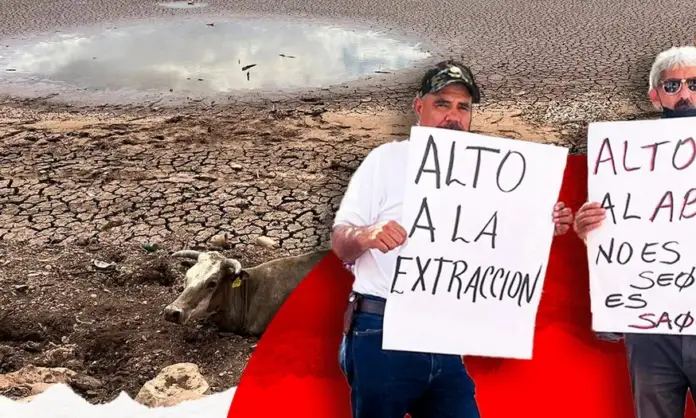
The constant dry environment in Chihuahua’s dams has generated an alert among farmers, ranchers, fishermen and residents in the northwest and south-central areas of the state.
This summer, the environmental damage was evident in the dams of La Laguna de Bustillos, located in the Anáhuac section, municipality of Cuauhtémoc, when last June tons of dead fish appeared due to the low level of water storage.
A similar atmosphere occurred at the end of August, in the La Lajas dam, located in the municipality of Buenaventura, northwest of Chihuahua. Its record has been the lowest of all: only 1.92 percent of its capacity.
A cow from a nearby ranch tried to approach to drink some of the water that remained in the dam, but got stuck halfway.
Omar Bazán, a local deputy, attributes the damage not only to the drought or extreme heat, but to illegal well concessions.
“It is worrying, it has to be investigated if there were acts of corruption in what is happening in the northwest of the state as in other parts of Chihuahua… having a ban, they were giving out illegal well concessions and this has its consequences. It must be investigated who gave the concessions, when they gave them and in exchange for what they gave them. We cannot cope with an ecocide like the one we are experiencing,” he said.
Las Lajas has a capacity of 82 million cubic meters of water, but now the livestock activities and crops of the farmers of the Benito Juárez and Ricardo Flores Magón ejidos have been put at risk.
“Our municipality is 90 percent agricultural, the majority is dedicated to the agricultural production of chiles, fodder and walnut trees. This dam supplies two irrigation modules: module 1 in Flores Magón and module 4 in Benito Juárez.
“The only approach I have had is with Rural Development of the State Government. The area around where the dead fish are has been addressed, it is not easy to even get close to the water, there is a lot of mud, it is dangerous. The population has been warned not to take the fish because they were trying to rescue them,” said the mayor of Buenaventura, Rogelio Pacheco.
A few kilometers away, residents of the community of San Lorenzo are suffering the ravages of the empty dam, like Alfredo González, a fisherman who lost his livelihood in a matter of weeks.
“We are talking about two months ago when the dam started to go down and it is not raining. I don’t know why they allowed it to dry out, it was so that they would not have taken water from it and we saw that they were taking water anyway, even though it was low,” he explains.
There are two aquifers in the basin and according to residents the conflict began due to the illegal use of producers, mainly Mennonites, who began to drill wells in the area.
While this was happening in Las Lajas, on August 28, residents of the La Boquilla dam, located in the municipality of Camargo, demonstrated to demand the immediate closure of the dam, since it is at 15.9 percent of its capacity.
The pressure was brought to bear the next day, to the doors of the Government Palace in Chihuahua, when the protesters pointed out that the main walnut-growing families in the municipality of Delicias are abusing the vital liquid.
“If it is not closed, the health of the ecosystem is put at risk, as well as public health. It is the beginning of the end and all for privileging a few with concessions,” said Ernesto Fernández, leader of the tourist complex of Lago Colina.
As a consequence of the lack of water, the inhabitants pointed out that they must carry the liquid to be able to supply the population and the animals, in addition to the fact that three complexes have already been closed in the area.
In an effort to address the severe water crisis, Arturo Zubía, director of Agriculture for the State Government, proposed bringing forward the agricultural cycle that ends on September 30.
The Hydraulic Committee that meets in the municipality of Delicias will be the one to determine whether the closure is shortened 15 days before in favor of the farmers, since the agricultural activity could be seriously affected and would impact the employment of around 25 thousand day laborers, who come from different parts of the country.
And while that happens, for the next 15 days there are no rain conditions for those areas.
Source: milenio






